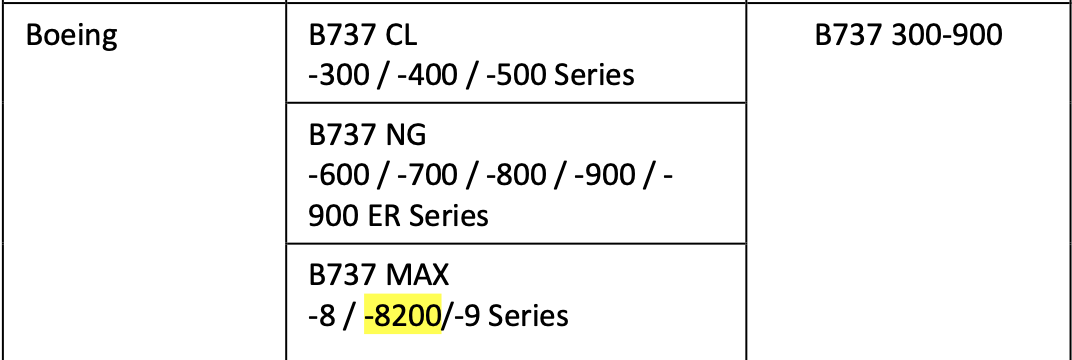Boeing 737 MAX requires type rating
Currently, the most common transition to the Boeing 737 MAX is for pilots who hold or have received type rating training or differences training on a Boeing 737 NG.
The very basic requirement to fly a Boeing 737 MAX is therefore being a holder of a valid type rating, which the EASA typing endorsement list establishes as B737 300-900. It generally allows flying on Classic generation, Next Generation and the very modern Boeing 737 MAX as follows:

Upon the type rating training completion, it is necessary to complete additional differences training for Boeing 737MAX in the simulator, which represents the Boeing 737 MAX cockpit layout in the following scope. This specific training is the result of additional certification and modification processes that was mandated as an outcome of the investigation after two deadly accidents.
Boeing 737 MAX theoretical knowledge instruction
- Runaway Stabilizer.
- SPEED TRIM FAIL.
- STABILIZER OUT OF TRIM.
- Stabilizer Trim Inoperative.
- Airspeed Unreliable.
- ALT DISAGREE.
- AOA DISAGREE.
1.2.1 ATA 22 – Autoflight – FCC – MCAS:
- MCAS function description.
- Conditions for operation.
- Erroneous FCC trim commands.
- Flight deck alerting of the failure of the MCAS function.
1.2.2 ATA 22 – Autoflight – FCC – AFDS:
- Automatic AP disengagement.
- Temporary FD removal.
- AFDS pitch mode changes following stick shaker.
- Inhibiting of AP nose up trim.
1.2.3 ATA 22 – Autoflight – FCC – STAB OUT OF TRIM:
- Alert illumination logic (ground vs. flight).
- Revised NNC.
1.2.4 ATA 22 – Autoflight – FCC – SPEED TRIM FAIL:
- Function of the SP
- Revised NNC
737 Manual Trim Operation:
- Manual stabilizer trim operation.
- Manual stabilizer trimming techniques.
- Effects of airspeed and aerodynamic loads on manual stabilizer trim operation.
737 Unreliable Airspeed – Determining a Reliable Airspeed:
- Recognition of flight deck effects of an unreliable airspeed condition.
- Memory pitch and thrust settings associated with the NNC.
- Determination of reliable airspeed indication.
Boeing 737 MAX simulator training
Demonstration of MCAS activation accomplished by each pilot acting as PF.
- MCAS activation during an impending stall (or full stall) and recovery demonstration during manual flight in a clean configuration.
Demonstrate MCAS activation stabilizer trim responses:
- Stabilizer trim in the nose down direction when above threshold AOA for MCAS activation during stall.
- Stabilizer trim in the nose up direction when below threshold AOA for MCAS activation during recovery.
Runaway stabilizer condition requiring use of manual stabilizer trim accomplished by each pilot acting as PF.
- Runaway stabilizer training
- Operation of each manual trim technique (as defined by Boeing).
- This training can be completed in a 737 MAX or 737NG FFS.
Use of manual stabilizer trim during approach, G/A, and level off by each pilot acting as PF.
-
Use of manual stabilizer trim as described in subparagraph
-
This training can be completed in a 737 MAX or 737NG FFS.
A Cross-FCC Trim Monitor activation demonstration accomplished by either pilot acting as PF.
- Condition must terminate in a landing in order to demonstrate the updated STAB OUT OF TRIM light functionality.
Erroneous high AOA during takeoff that leads to an unreliable airspeed condition accomplished by either pilot acting as PF.
- Demonstrates flight deck effects (i.e., aural, visual, and tactile) associated with the failure.
- Fault occurring during the takeoff procedure.
- Must include a go-around or missed approach flown with erroneous high AOA condition.
- Special emphasis placed on FD behavior biasing out of view upon selecting takeoff/go-around (TO/GA).

